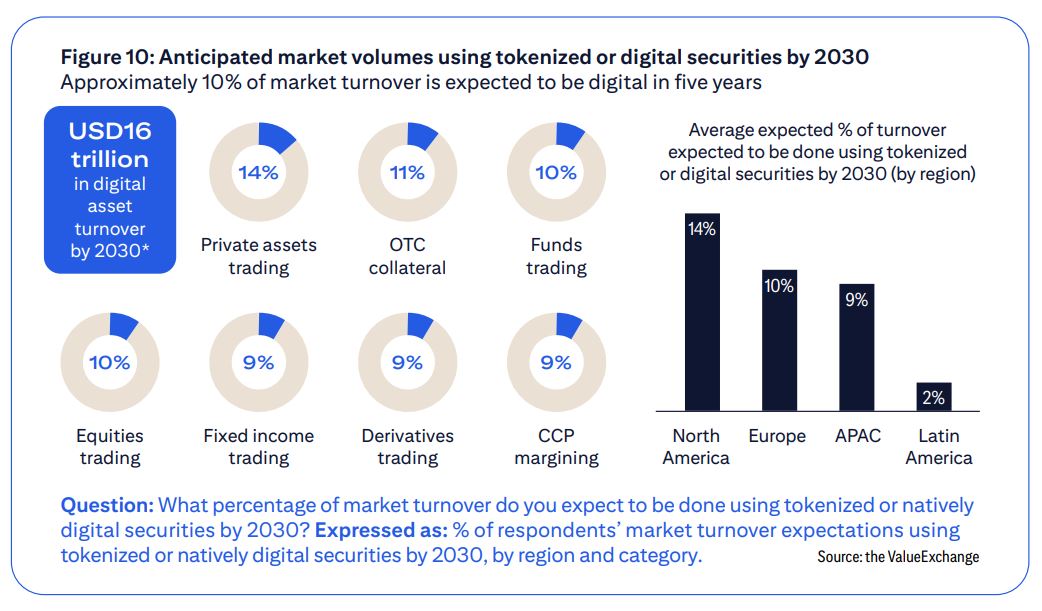Post-trade tokenization is poised to handle roughly 10% of global market turnover by 2030, with bank-issued stablecoins leading collateral efficiency and fund tokenization. A Citi survey of 537 finance firms shows U.S. markets expect the highest adoption (14%), driven by regulation and institutional support.
-
10% of global post-trade turnover may be tokenized by 2030
-
U.S. respondents expect ~14% tokenized turnover; Europe 10%, Asia Pacific 9%
-
57% of firms are piloting GenAI for post-trade operations; 67% of institutional investors use GenAI for reconciliation and clearing
post-trade tokenization: Citi survey finds ~10% of market turnover may use stablecoins and tokenized securities by 2030. Read how institutions plan to adapt.
What is post-trade tokenization and how will stablecoins be used?
Post-trade tokenization is the process of representing securities and collateral as digital tokens to streamline verification, settlement and custody. Citi’s survey indicates bank-issued stablecoins will be the primary vehicle to improve collateral efficiency, fund tokenization and private market access by 2030.
How much market turnover will stablecoins and tokenized securities handle by 2030?
Citi polled 537 custodians, banks, broker-dealers, asset managers and institutional investors across the Americas, Europe, Asia Pacific and the Middle East. The aggregate expectation is that about 10% of post-trade market turnover could be conducted with stablecoins or tokenized securities by 2030. Regionally, the U.S. expectation is highest at 14%, Europe at 10% and Asia Pacific at 9%.
The survey also highlighted drivers: liquidity improvements and lower post-trade costs were cited as primary reasons for investing in distributed ledger technology (DLT). Respondents noted that tokenization can materially cut funding costs and operating expenses before 2028.

Why are bank-issued stablecoins seen as central to post-trade evolution?
Bank-issued stablecoins are perceived as providing regulatory alignment, familiar counterparty credit profiles and easier integration with existing treasury and settlement systems. Citi’s report states institutions believe these tokens will best support collateral mobility and private fund tokenization without compromising compliance frameworks.
Survey respondents also pointed to institutional leadership — including stablecoin issuers and large asset managers — as key to scaling digital liquidity. The regulatory environment, particularly recent U.S. legislation, has further increased confidence among market participants.
Plain-text reference: Citi – Securities Services Evolution report (survey of 537 industry participants). Plain-text reference: reporting on regulatory change including the GENIUS Act signed into law in July 2025.
How will GenAI affect post-trade operations?
Generative AI is being piloted by 57% of respondents for post-trade workflows. At least 67% of institutional investors reported using GenAI for reconciliation, reporting, clearing and settlements. Onboarding is the most common GenAI use case: 83% of brokers, 63% of custodians and 60% of asset managers cited onboarding pilots that aim to speed client integration and reduce manual friction.

Frequently Asked Questions
Will tokenized securities replace traditional post-trade systems?
Tokenized securities will complement and gradually integrate with legacy post-trade systems rather than immediately replace them. Institutions expect a phased transition focused on specific asset classes and use cases that deliver clear cost and speed advantages.
How soon can institutions expect widespread tokenization?
Market participants in the Citi survey expect material adoption by 2030, with notable impacts on liquidity and costs before 2028 as pilots scale into production for targeted workflows.
Are stablecoins safe for collateral use?
Survey respondents favor bank-issued stablecoins due to perceived regulatory alignment and governance. Risk mitigation will depend on issuer credibility, custody arrangements and supervisory frameworks established by regulators.
Key Takeaways
- Adoption outlook: ~10% of post-trade turnover may be tokenized by 2030, with higher U.S. expectations.
- Primary driver: Liquidity and post-trade cost efficiencies are fueling DLT investment and tokenization pilots.
- Tech enablers: Bank-issued stablecoins and GenAI are central to near-term transformation strategies.
Conclusion
The Citi survey shows post-trade tokenization is moving from experimentation toward strategic deployment, with stablecoins in post-trade and GenAI driving practical efficiency gains. Market participants should prioritize pilots that demonstrate clear cost and liquidity benefits and prepare operational frameworks for tokenized securities by 2030. COINOTAG will continue tracking developments and institutional adoption.
